Perfect stick bread recipe for campfires and grills: simple basic recipe, with and without yeast, as well as without a stick
The most comprehensive guide to baking stick bread. Recipes with/without yeast, sweet stick bread as well as tips for baking and how to bake without sticks.
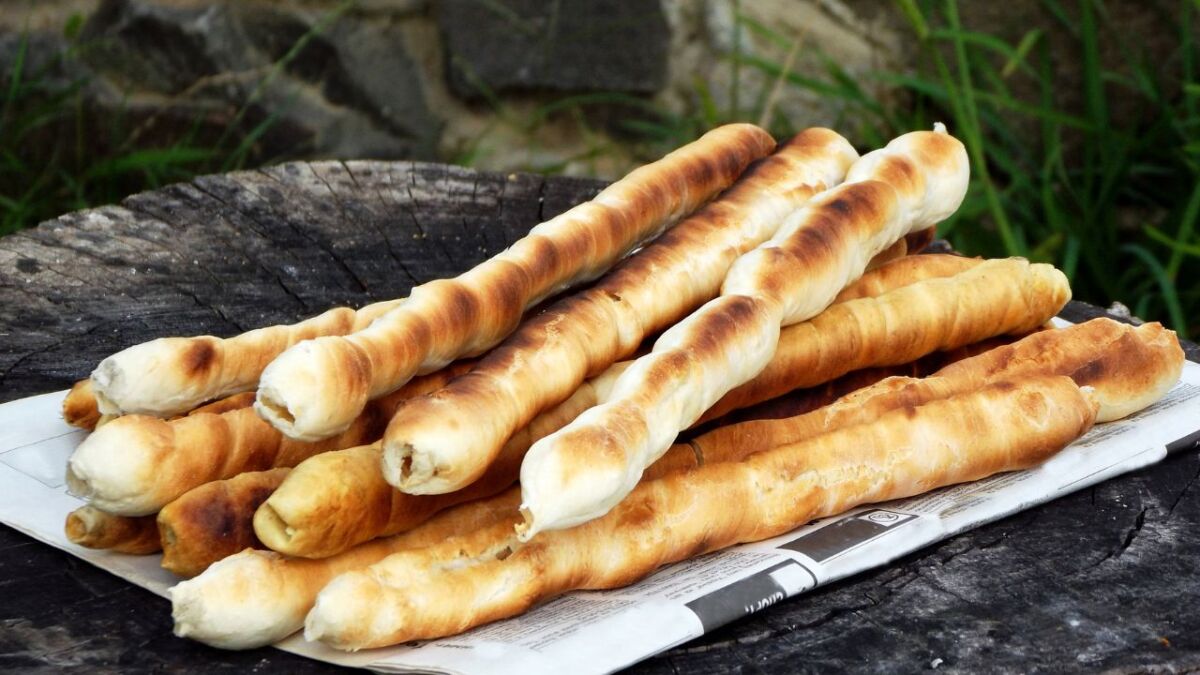

From Martin Gebhardt. Check out my “About me” page.
👉 The key facts from this guide
- Stick bread recipe with yeast
- Stick bread recipe without yeast
- Sweet stick bread recipe
- Stick bread without sticks, in case your children lack patience
- Stick bread is a simple and delicious recipe that you can prepare over an open fire or grill. You only need a few ingredients and a bit of patience.
- There are many variations of the basic recipe, including sweet and savory versions, as well as options for those who do not want to use yeast.
- Choosing the right stick is important for successfully baking stick bread. The stick should be long enough to protect you from the heat of the fire and sturdy enough to hold the weight of the dough.
- Baking stick bread over the embers of a keyhole fire is an excellent method, as it provides even and controllable heat.
- There are many ways to vary and refine your stick bread dough. You can add different herbs and spices, cheese, meat, or sweet ingredients.
- If you don't have sticks on hand, you can also bake the stick bread on a grill grate. Simply shape the dough into thin rounds and place them on the grate over the embers.
Stick bread is a delicious and entertaining way to bake bread over a campfire or grill.
It's easy to prepare and requires only a few ingredients.
In this article, I will explain the basic recipe for stick bread and also present variations without yeast.
Additionally, I'll give you tips on what to do when your kids lose interest in holding the stick bread after 5 minutes.
From sticky beginnings to coveted stick breads
Ah, the memories of my first stick bread are still so fresh, as if it were yesterday.
Imagine holding a sticky ball of dough in your hand that turns into more charcoal than bread in the open fire and is still raw inside.
A true masterpiece, isn't it? 🙄
In addition to that, my kids - the little wildlings - lost interest after five minutes and preferred to romp around in the forest.
And there I was, with three sticks in my hand and a fire that needed my attention.
It was like a juggler who suddenly realizes that he has too many balls in the air.
I remember looking into the fire and thinking to myself, "There has to be an easier way to make stick bread."
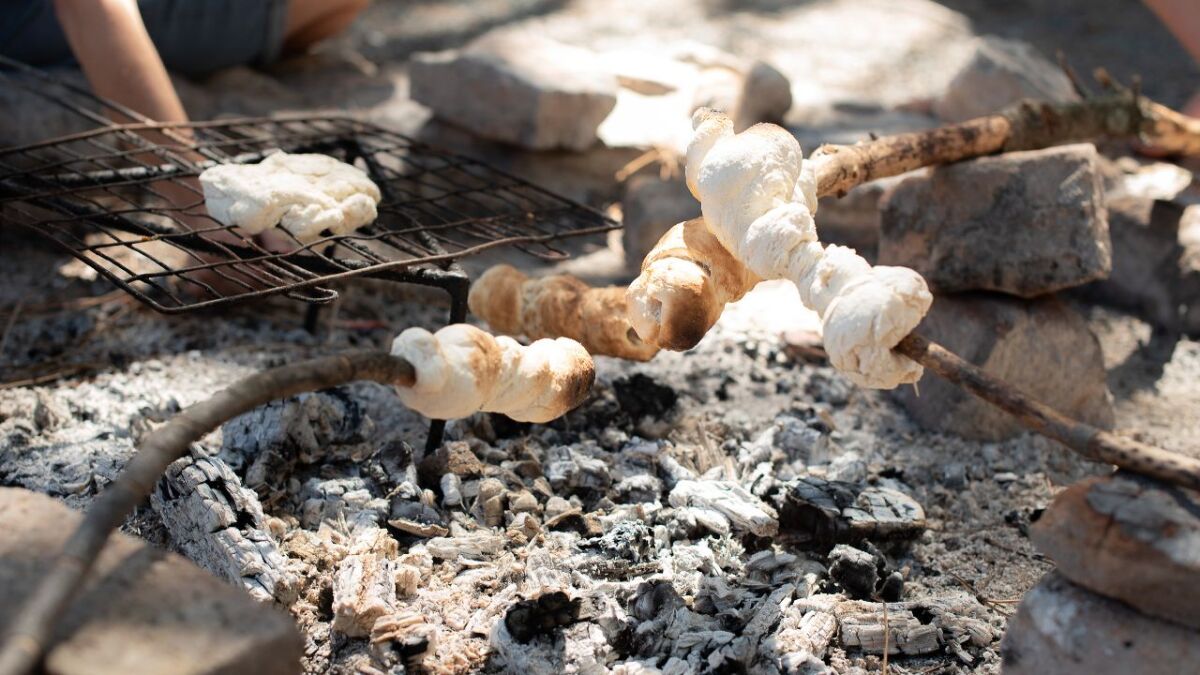
And you know what?
It is easier.
Today, after many campfires and countless stick breads, I have figured out how to prepare stick bread.
My stick breads are now so coveted that they disappear faster than a squirrel can crack a pine cone.
It's as if the forest is speaking to me, revealing its secrets to me. And one of those secrets is the perfect stick bread.
It's more than just a simple pastry, it's a symbol of outdoor life, of the joy of simple things.
What is stick bread, and how can I make it myself? (Recipe)
Stick bread is bread that is baked over coals on a stick. It is an ideal activity for campfires, family celebrations, or outdoor picnics. The basic recipe for stick bread requires only a few ingredients, including flour, yeast, salt, and water.
What are the ingredients for a simple stick bread?
The ingredients for the classic stick bread recipe are:
| Amount | Ingredients |
|---|---|
| 500 g | Flour |
| 1 packet (7 g) | Dry yeast |
| 1 tsp | Salt |
| approx. 300 ml | Warm water |
With these measurements, you will get about 8 portions.
How do I prepare the dough for stick bread?
| Step | Preparation |
|---|---|
| 1 | Mix the flour (500 g), dry yeast (7 g), and salt (1 tsp) in a bowl. |
| 2 | Add the warm water (300 ml). |
| 3 | Knead all the ingredients until a smooth dough forms. |
| 4 | If the dough is too dry, add more water. |
| 5 | If the dough is too wet, add more flour. |
| 6 | Let the kneaded dough rest covered in a warm place for at least 30 minutes. |
Tip: You can also prepare the dough at home and then take it with you.
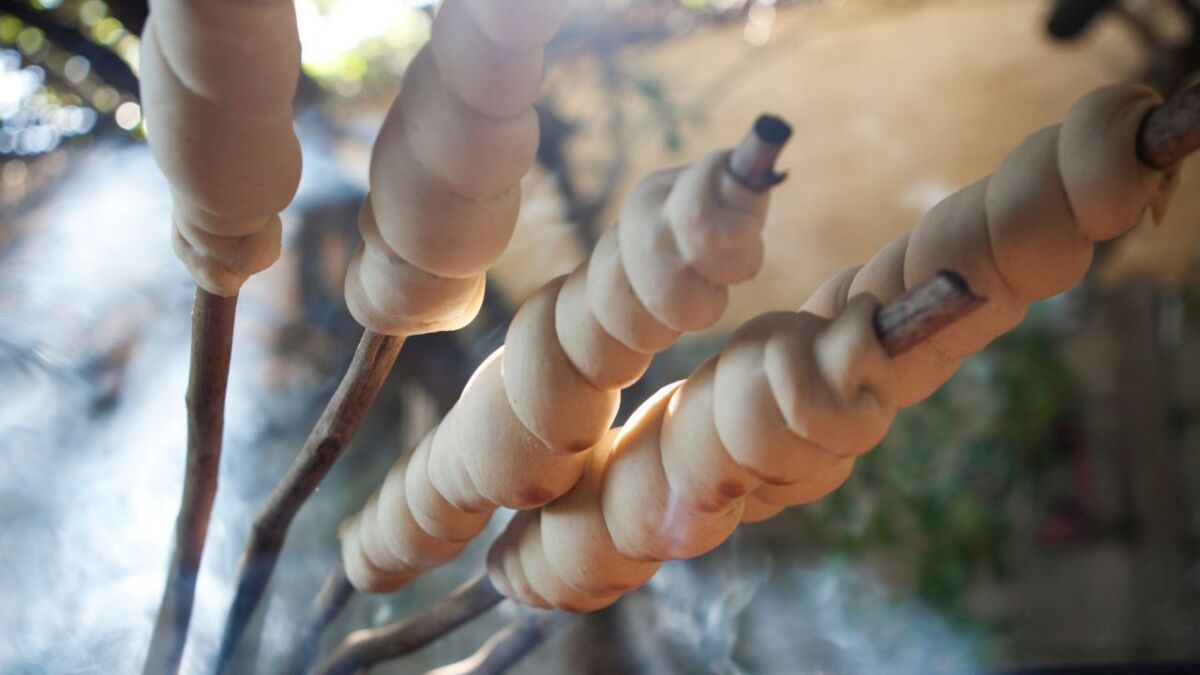
If you don't have time, I recommend excluding the yeast and using baking powder instead.
Further down in the guide, I have a recipe for that, and I only use this one now - it's easier and faster (no preparation time required). 😊
What portions are suitable for stick bread over the campfire?
To bake stick bread over the campfire, you should divide the dough into 8 pieces and shape them into 20 cm long rolls.
The pieces should be thin enough to wrap around the stick.
A good tip is to rub olive oil on the stick bread before wrapping it around the stick.
How do I simply bake stick bread?
How do I wrap the stick bread around the stick?
Take a piece of dough and shape it around the stick. Start at the bottom and wrap the dough tightly around the stick until you reach the top.
At the top, seal the bread so that no wood sticks out from the stick. If wood sticks out, it will burn and your bread will often catch fire too.
Make sure the dough is evenly thick so that it bakes evenly at all spots.
How long does the stick bread need to be baked over the coals?
The stick bread needs to be baked for about 10 minutes over the coals. Hold the stick about 20 cm above the hot coals.
If the coals are not hot enough, it may take longer.
When the stick bread is finished baking, it should have a golden brown color and come off the stick easily.
If it doesn't come off the stick easily, it is likely still soft inside.
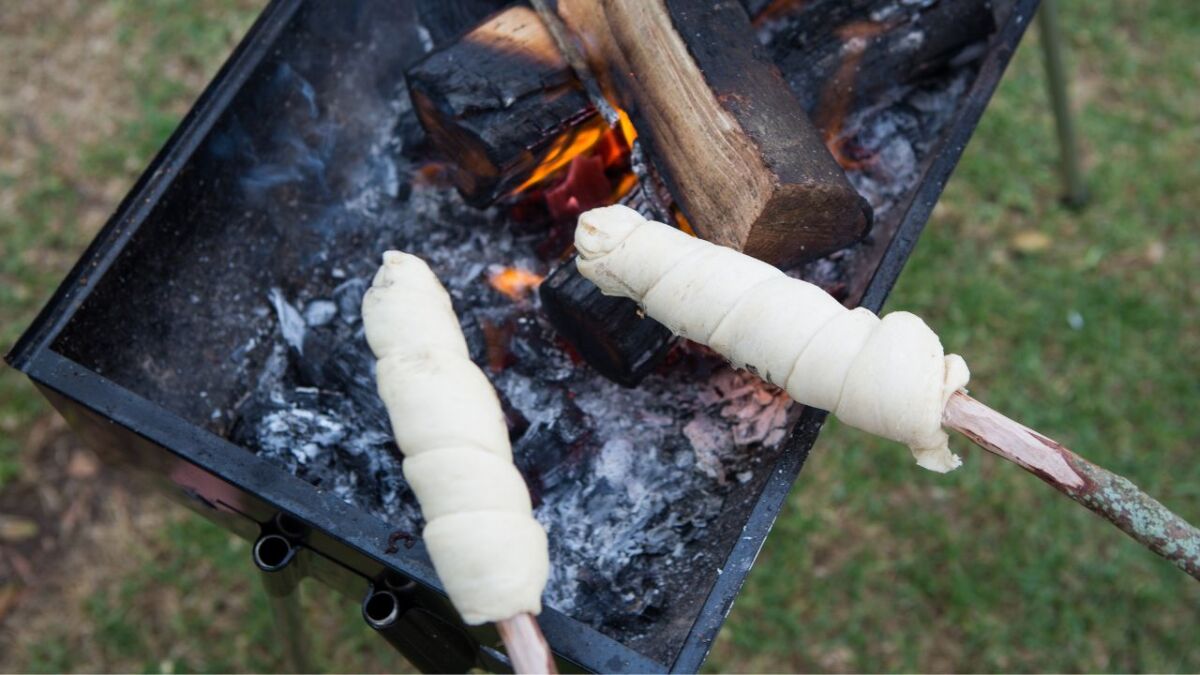
Can I also bake stick bread over an open fire?
You can bake stick bread over an open fire. However, it is better to do it over the coals. This way, you avoid the bread burning on the outside before it is fully cooked inside.
It is often better to cook over coals, which provide a more even and controllable heat.
A keyhole fire is an excellent method for baking stick bread.
A keyhole fire consists of two parts:
- a round, deeper part where the fire burns and wood turns into coals
- a shallower "keyhole" part where the coals are pushed
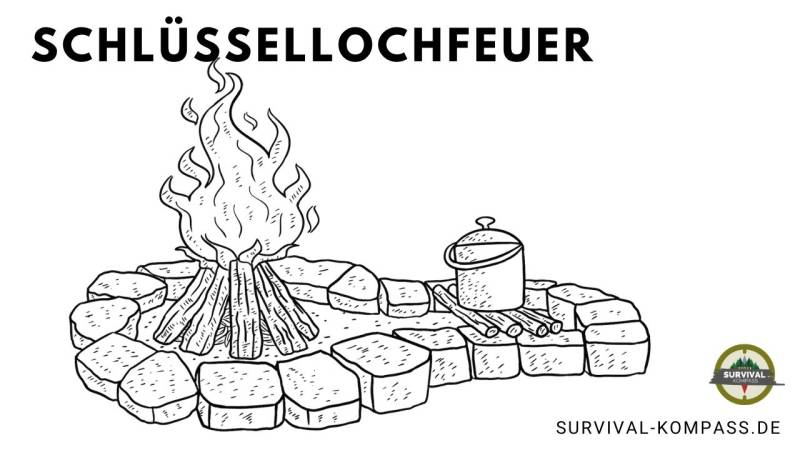
The coals of the keyhole fire provide a more even and controllable heat, which is ideal for baking stick bread.
Here's how you do it:
- Build your keyhole fire by digging a round, deep area for the fire and a flat, narrow area for the coals.
- Start the fire in the round part and gradually add wood until you have a good number of coals.
- Push the coals into the flat, keyhole-shaped area.
- Bake your stick bread over the coals by turning it regularly to ensure even baking.
- Enjoy your perfectly baked stick bread!
This method requires a little more preparation than baking over a regular campfire, but the result is a delicious, evenly baked stick bread.
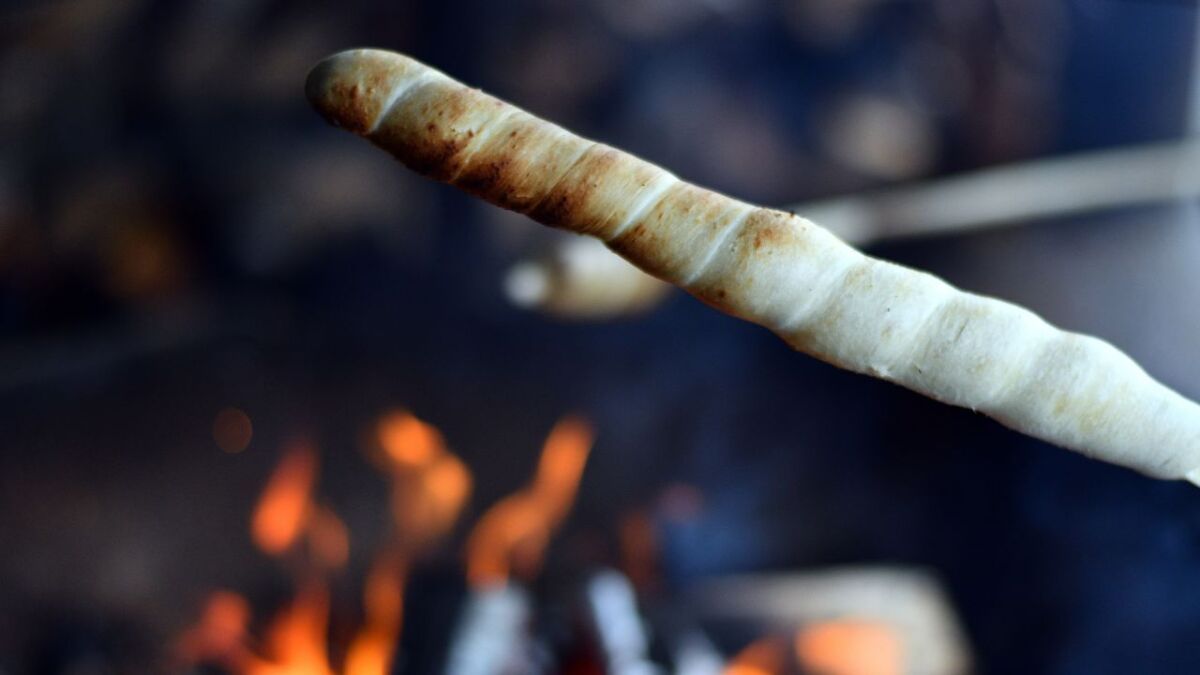
What ingredients can you add to the stick bread dough?
There are many ways to vary and refine your stick bread dough. Here are some ideas:
- Herbs and spices: You can incorporate different herbs and spices into the dough to give it additional flavor. Popular options are garlic, rosemary, basil, thyme, and oregano. You could also use spice blends like Italian seasoning or herbs de Provence.
- Cheese: Cheese is another great ingredient for stick bread. You could incorporate grated cheese into the dough or use small pieces of cheese like mozzarella or feta. The cheese will melt while the bread bakes, resulting in a delicious, cheesy interior.
- Meat: Ham or sausage can also be incorporated into the dough. You could use small pieces of cooked ham or salami, for example. Just make sure the meat is already cooked, as the stick bread probably won't bake long enough to cook raw meat.
- Sweet ingredients: For sweet stick bread, add sugar, cinnamon, vanilla sugar, or even chocolate chips to the dough. You could also use raisins or dried cranberries.
- Vegetables: Finely chopped or grated vegetables like onions, bell peppers, or olives can also be incorporated into the dough.
Experiment with different ingredients and find out what tastes best to you. The great thing about baking stick bread is that you can customize it to your taste.
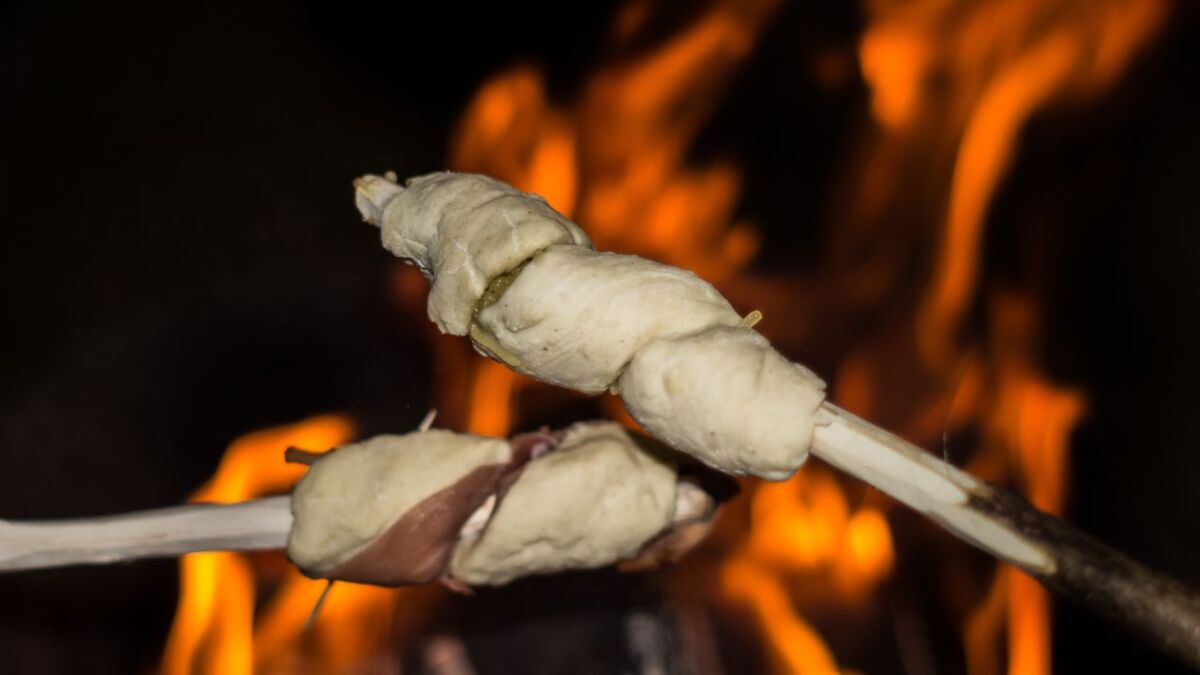
How can I make sweet stick bread? (Recipe)
To make sweet stick bread, you can enrich the dough with sweet ingredients and garnish the finished bread with sweet toppings.
Here's a simple recipe:
Ingredients for sweet stick bread:
| Quantity | Ingredients |
|---|---|
| 500 g | Flour |
| 1 packet (7 g) | Dry yeast |
| 50 g | Sugar |
| 1 pinch | Salt |
| 250 ml | Milk |
| 50 g | Butter |
| Optional | Cinnamon, vanilla sugar, chocolate chips |
Preparation:
| Step | Preparation |
|---|---|
| 1 | Mix the flour (500 g), dry yeast (7 g), sugar (50 g), and salt (pinch) in a large bowl. |
| 2 | Heat the milk (250 ml) and butter (50 g) in a saucepan until the butter has melted. The mixture should be warm, but not hot. |
| 3 | Pour the milk-butter mixture into the bowl with the dry ingredients and knead everything into a smooth dough. If desired, you can now add additional sweet ingredients like cinnamon, vanilla sugar, or chocolate chips. |
| 4 | Cover the bowl and let the dough rise in a warm place for about 1 hour, until it has doubled in size. |
| 5 | Divide the dough into about 10 equal pieces and shape each piece into a long snake. |
| 6 | Wrap the dough snakes around the ends of the sticks, making sure the dough is evenly distributed. |
| 7 | Bake the stick bread over the embers of a campfire, turning it regularly, until it is golden brown and cooked through. This can take 10–20 minutes, depending on the heat of the fire. |
| 8 | Let the stick bread cool for a few minutes before eating. You can also sprinkle it with additional sugar or cinnamon if desired. |
Have fun baking and enjoying your sweet stick bread!
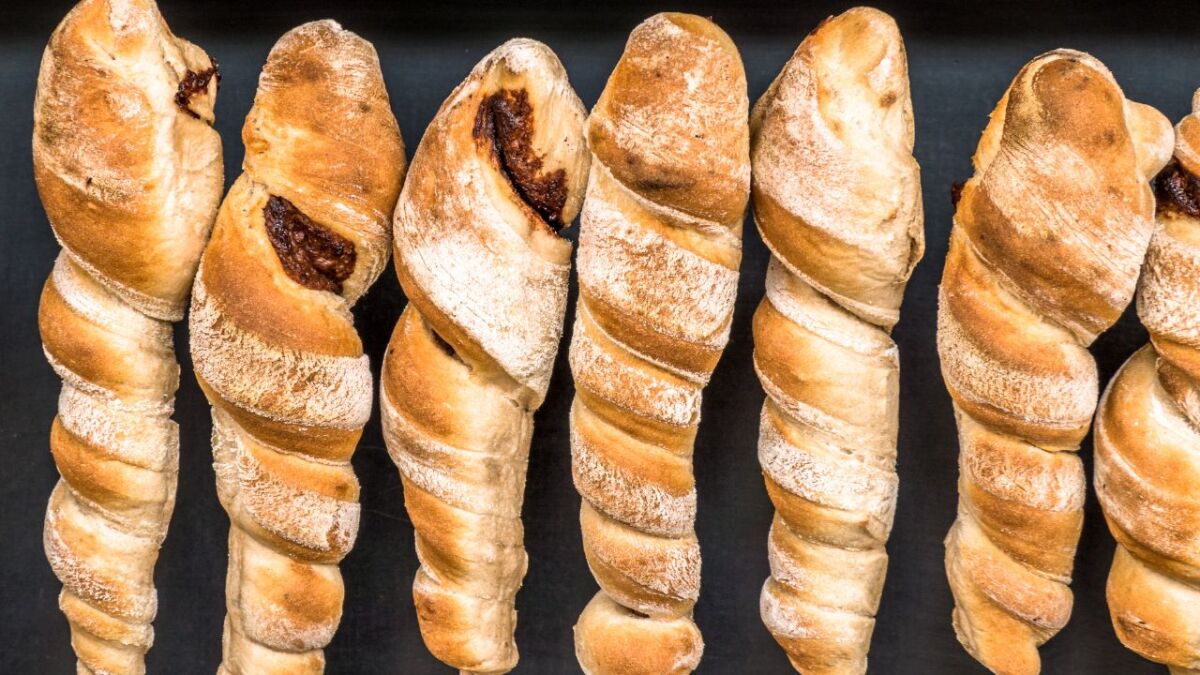
Recipe without yeast: How to prepare stock bread without yeast dough? (Recipe)
If you're not a fan of yeast, you can make stock bread without yeast. Use baking powder instead.
Here is a simple recipe without yeast:
Ingredients:
| Quantity | Ingredients |
|---|---|
| 500 g | Flour |
| 2 tsp | Baking powder |
| 1 tsp | Salt |
| 2 tablespoons | Sugar (optional, for sweet stock bread) |
| 250 ml | Water |
| 50 ml | Oil |
Preparation:
| Step | Preparation |
|---|---|
| 1 | Mix the flour (500 g), baking powder (7 g), salt (1 tsp), and sugar (if used) in a large bowl. |
| 2 | Add the water (250 ml) and oil (50 ml) and knead everything into a smooth dough. If the dough is too sticky, add more flour. If it is too dry, add more water. |
| 3 | Divide the dough into about 8 to 10 equal pieces and shape each piece into a long snake. |
| 4 | Wrap the dough snakes around the ends of the sticks, making sure the dough is evenly distributed. |
| 5 | Bake the stick bread over the embers of a campfire, turning it regularly, until it is golden brown and cooked through. This can take 10–20 minutes, depending on the heat of the fire. |
| 6 | Let the stick bread cool for a few minutes before eating. |
This yeast-free recipe is ideal for spontaneous trips in nature, as you don't need yeast and the ingredients are easy to transport.
Tip: I prepare the baking mix at home in a ziplock bag. When I'm outdoors, I just add water to the bag and knead everything together in the bag. This way, my fingers stay clean.
Often I even use an even simpler baking mix for my bread:
- 2 cups of flour
- 1 cup of water
- 2 teaspoons of baking powder
- ½ teaspoon of salt
Furthermore, the bread can be enhanced with various ingredients, such as bread spices, onions or chili peppers, herbs (rosemary, wild garlic, dandelion), chopped nuts (hazelnuts or walnuts) or sugar for sweet bread.
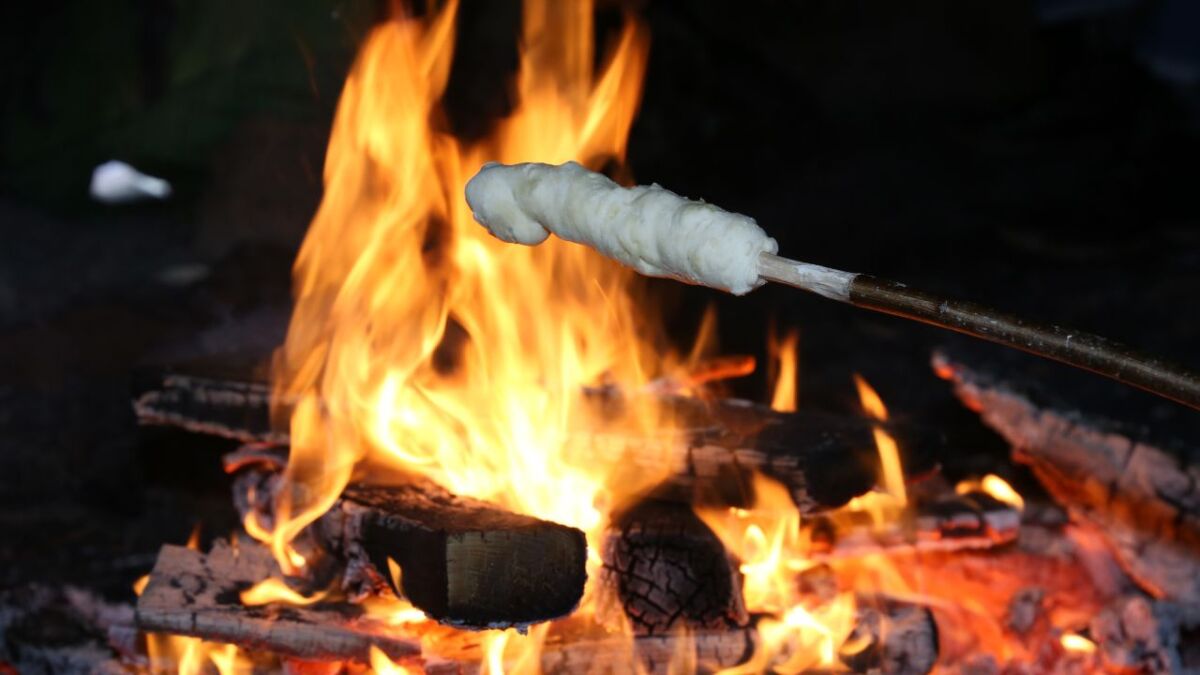
What is the difference between yeast and baking powder in bread dough?
Yeast and baking powder are both leavening agents used in baking recipes to make the dough rise.
However, they work in different ways and produce different results:
Yeast in stick bread dough - What happens there?
Yeast is a living organism that converts sugar into alcohol and carbon dioxide. This process is called fermentation.
The carbon dioxide produced during fermentation forms bubbles in the dough, causing the yeast dough to rise and give it a fluffy texture.
Yeast requires time to work, so yeast-containing doughs usually need to rest for a while before being baked.
Yeast is often used in bread recipes and gives a characteristic flavor.
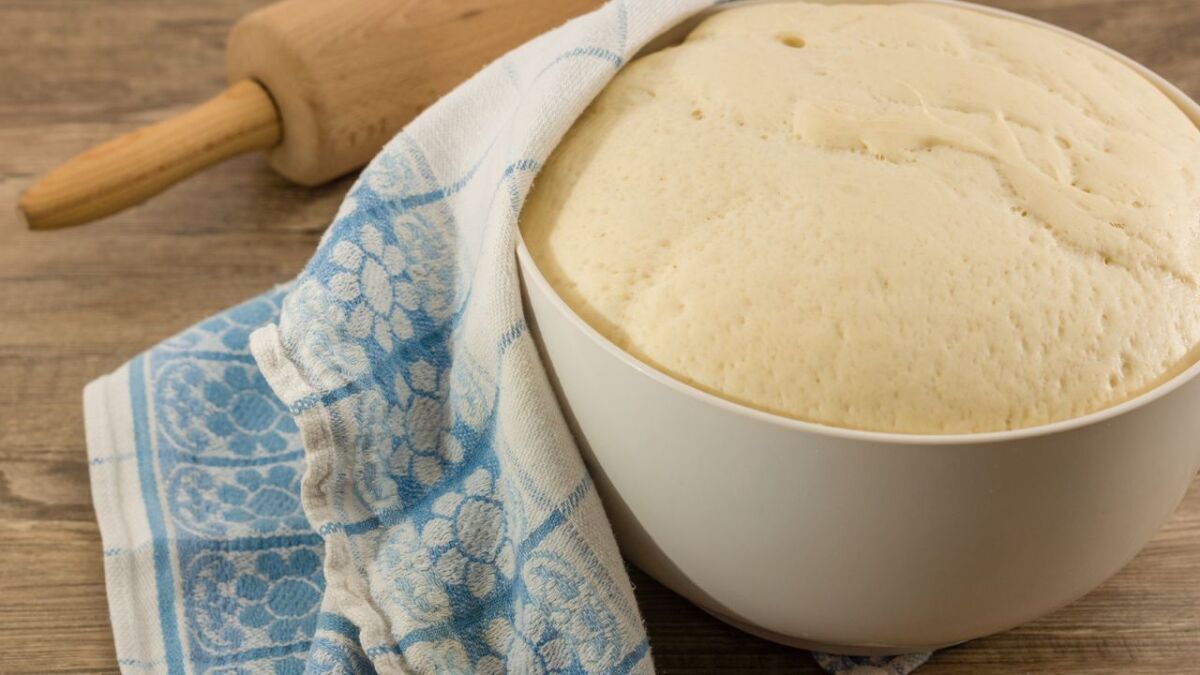
Baking powder in stick bread dough - What happens there?
Baking powder consists of an acid and a base that react with each other when they come into contact with liquid and heat.
This reaction also produces carbon dioxide, which creates bubbles in the dough and makes it rise.
Unlike yeast, baking powder works quickly and does not require resting time, so it is typically used in recipes for cakes, muffins, and other quick breads.
Baking powder does not impart any specific flavors to the dough, but it is just as fluffy as yeast.
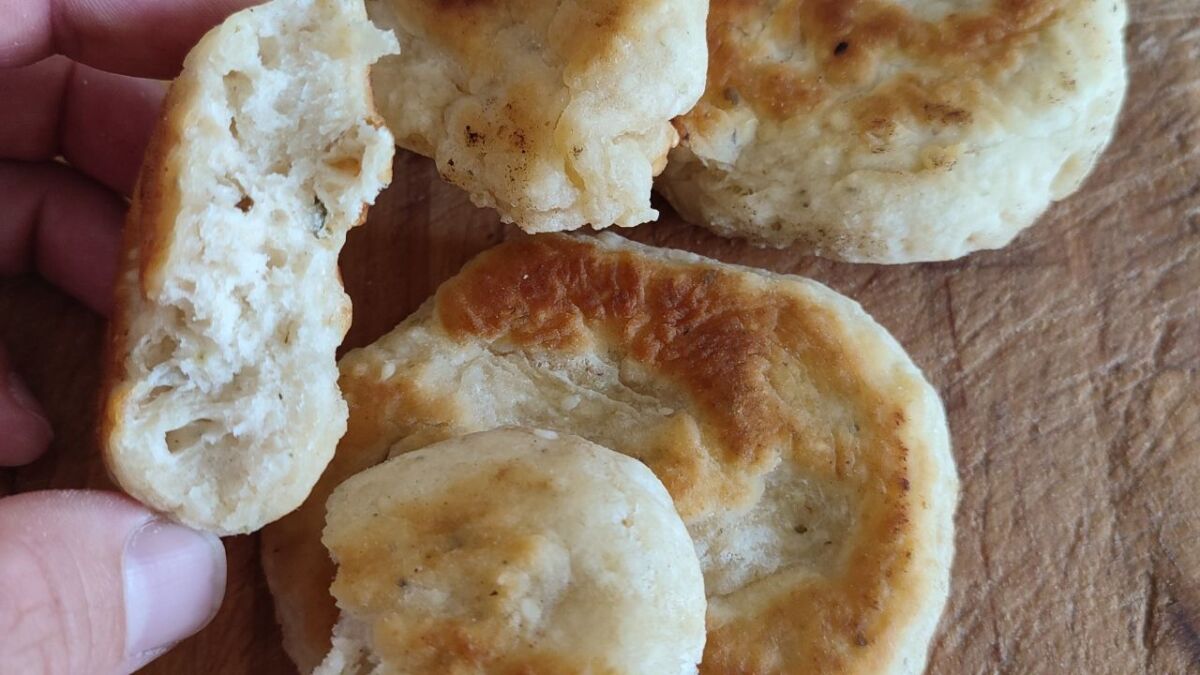
What is the difference between water and milk in stick bread dough?
Both water and milk can be used as liquids in stick bread dough, but they produce different results:
Water in stick bread dough - What happens there?
Water is the simplest and most commonly used liquid in bread doughs. It hydrates the flour and allows the gluten to form, which is necessary for the structure of the bread.
Breads made with water only generally have a firmer crust and a denser crumb (the interior of baked goods).
Milk in stick bread dough - What happens there?
Milk changes the texture of the bread, making it softer and more tender. This is because the proteins and fats in the milk slow down gluten formation, resulting in a less elastic dough.
Milk can also help the bread achieve a nicer browning, and it can give the bread a slightly sweet taste.
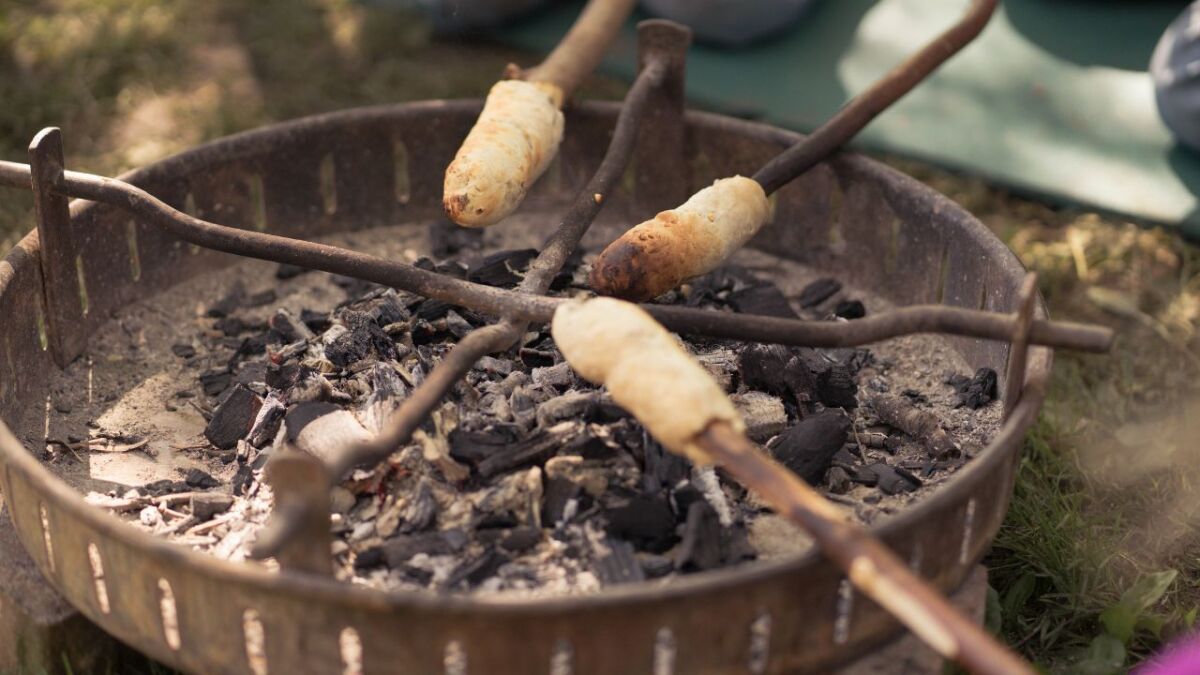
Whether you should use water or milk in your stick bread dough depends on your personal preferences and the desired result.
If you want a softer, more tender bread with a impressive browning, milk may be the better choice.
If you prefer a firmer bread with a strong crust, water is likely the better option.
Read also
3 types of bread you can bake in the wilderness without an oven - Baking bread in the wilderness without an oven? Yes, that's possible. In this article, you will learn how to do it with just a campfire and a frying pan or stick.
How do you bake stick bread on the grill?
Stick bread can also be baked on the grill.
Wrap the dough around the stick as usual and place it on the grill.
Make sure the grill is not too hot and rotate the bread regularly.
The baking process should take about as long as on the campfire.
Overall, stick bread is a hit at any campfire or barbecue party, and you can customize it to your liking.
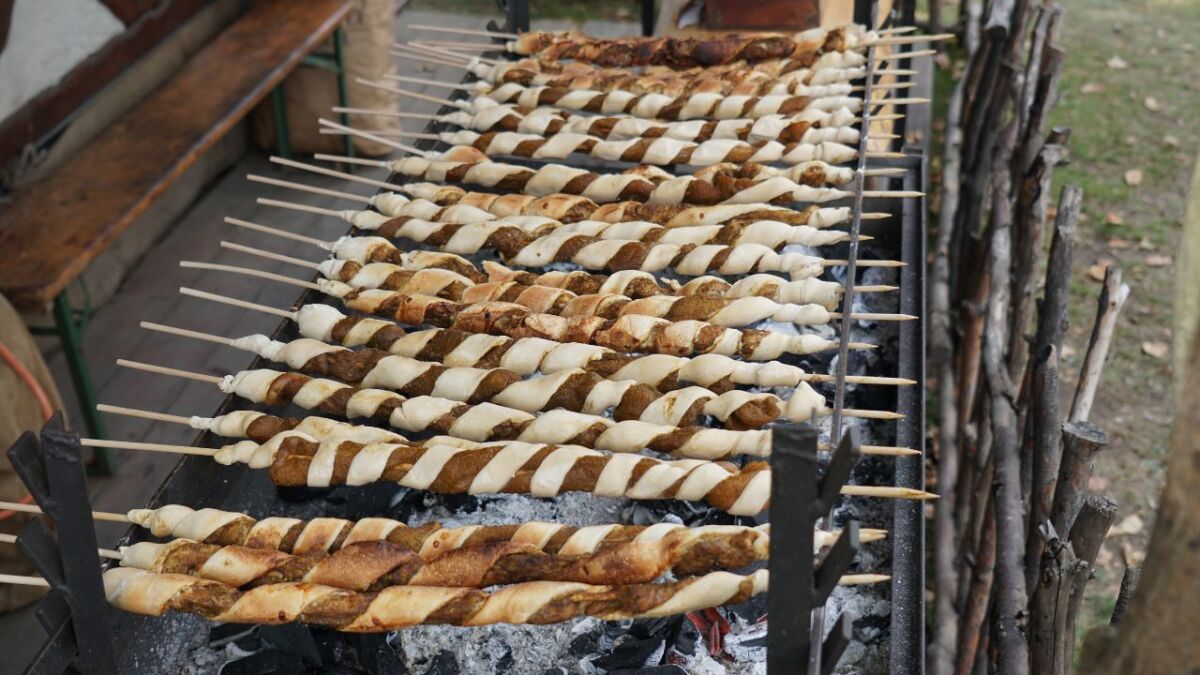
What kind of sticks do I need for making stick bread?
For making stick bread, you require long, sturdy sticks. Here are some tips for finding the right stick:
- Length: The stick should be long enough to keep you at a safe distance from the embers. A length of about 1-1.5 meters is usually sufficient.
- Thickness: The stick should be thick enough to support the weight of the dough, but not so thick that the dough cannot be wrapped around it properly. A thickness of about 1-2 cm is ideal.
- Material: Use a stick from a non-toxic tree or shrub. Suitable options include hazelnut, apple, birch, or ash. Avoid poisonous trees such as yew, robinia, acacia, or oleander.
- Condition: The stick should be dry and dead, but not rotten or brittle. A green stick can also be used, but it may contain moisture that may escape when heated.
- Preparation: Peel off the bark from the end of the stick you are using for baking. This helps remove bacteria and prevents the bark from getting into your bread.
You see, the process of making stick bread does not only take place in front of the fire. It is a good idea to combine baking with a carving mission.
If you are starting with bushcraft, such a project is perfect. Your children will learn how to handle a knife and identify trees.
And who knows, maybe they will be keen to continue with more wilderness ideas afterward.
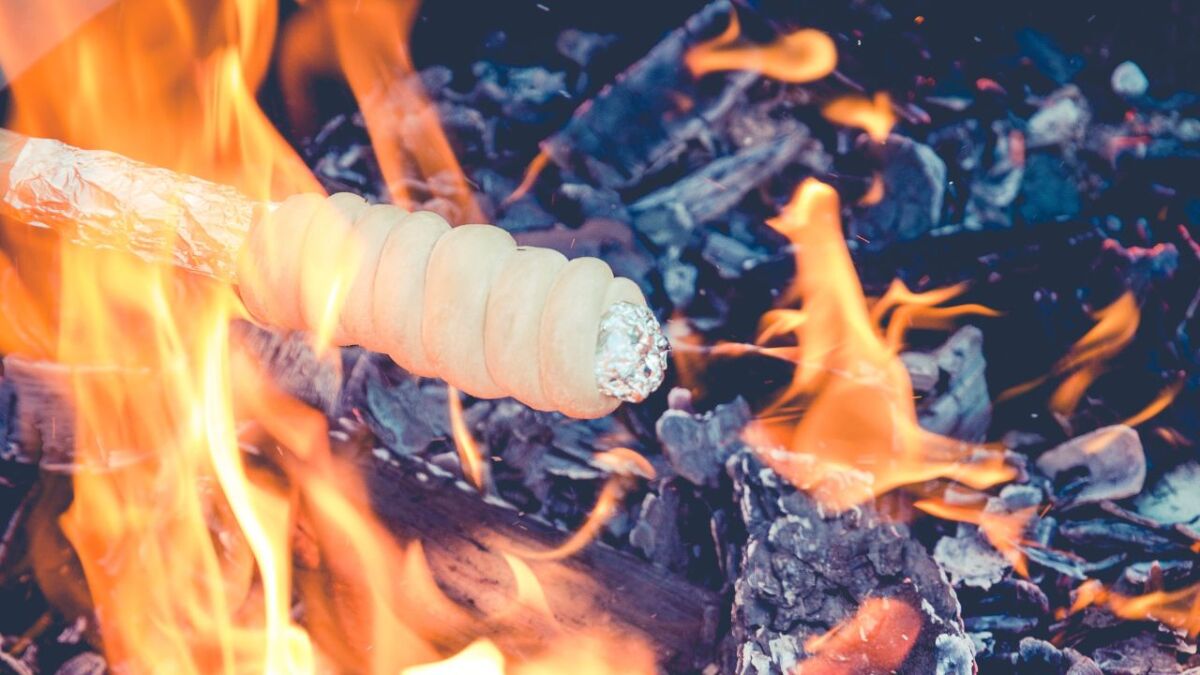
What can I eat with stick bread?
Stick bread - this wonderful invention of nature that allows us to satisfy our stomachs in the simplest and most delicious way over a campfire.
You have skillfully shaped the stick bread dough, wrapped it around the stick, and baked it over the fire, and now you may be looking for more adventures for your palate.
Don't worry, cooking enthusiasts like you and me know that creativity in the wilderness never ends.
Think savory
Slices of good cheese, ham, or smoked salami are the perfect tasty accompaniment - and they taste delicious when warmed by the heat of the fire.
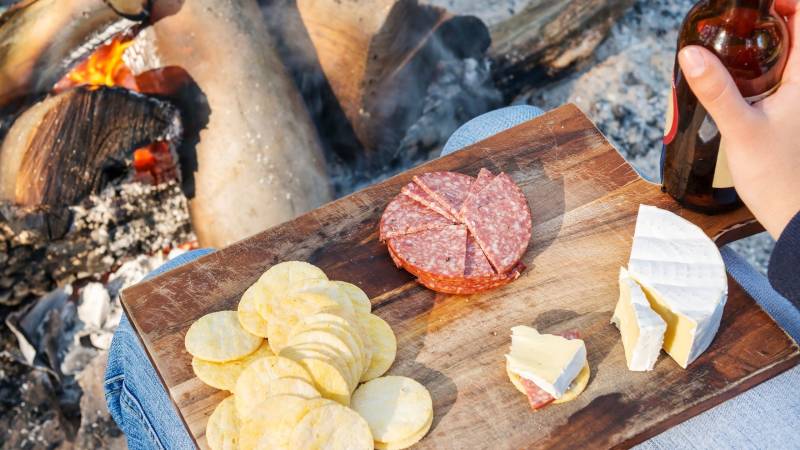
Let's explore the sweet side
What could be better than sticky, delicate honey dripping in thick drops over your fresh stick bread?
And who could forget chocolate spread or jam? It always tastes delicious, no matter how far you ventured into the woods.
Vegetables go well with it
Do you love nature, the green beauty around you, the vibrant vegetation?
Then listen up: grilled vegetables, like peppers, zucchini, or eggplant, can turn your stick bread into a true vegetarian delight.
Or how about dips?
A homemade mixture of delicious herbs, quark, garlic, or for chickpea lovers, hummus, or guacamole offer a great variety of taste experiences.
You see: The possibilities are almost limitless.
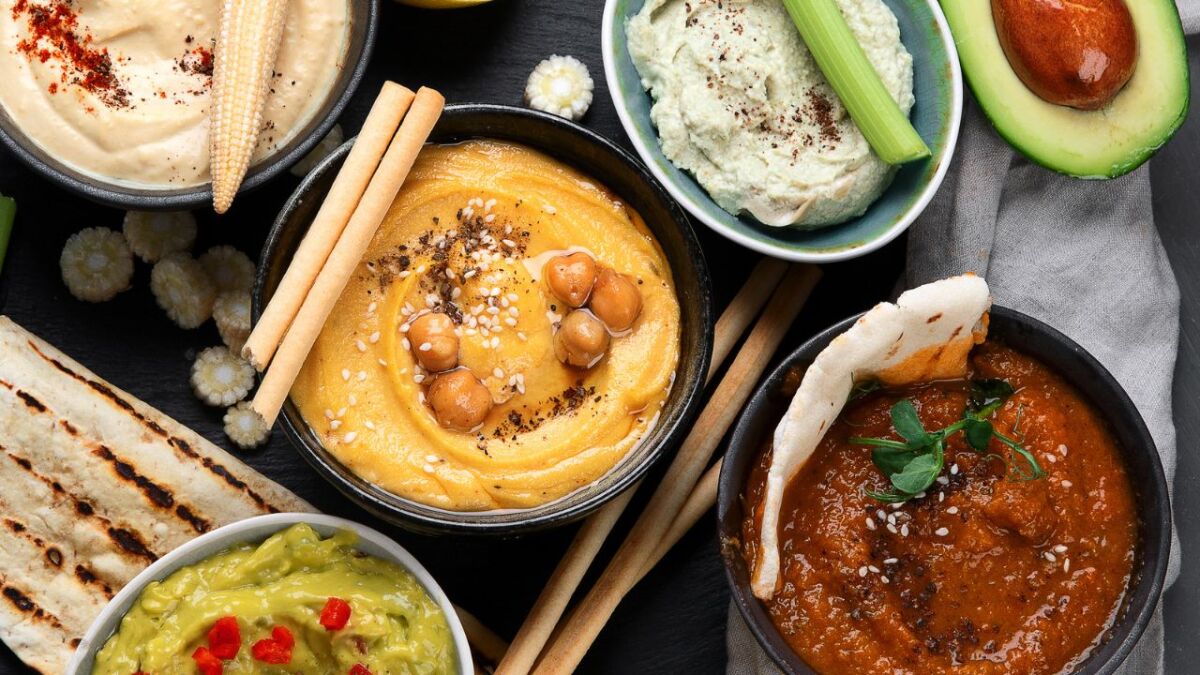
How can I bake stick bread without sticks?
Have you ever experienced your children gradually losing interest in turning the stick while baking stick bread?
Don't worry, I have the perfect solution for you.
All you need is a grill grate and a few flat breads to create a great alternative to traditional stick bread.
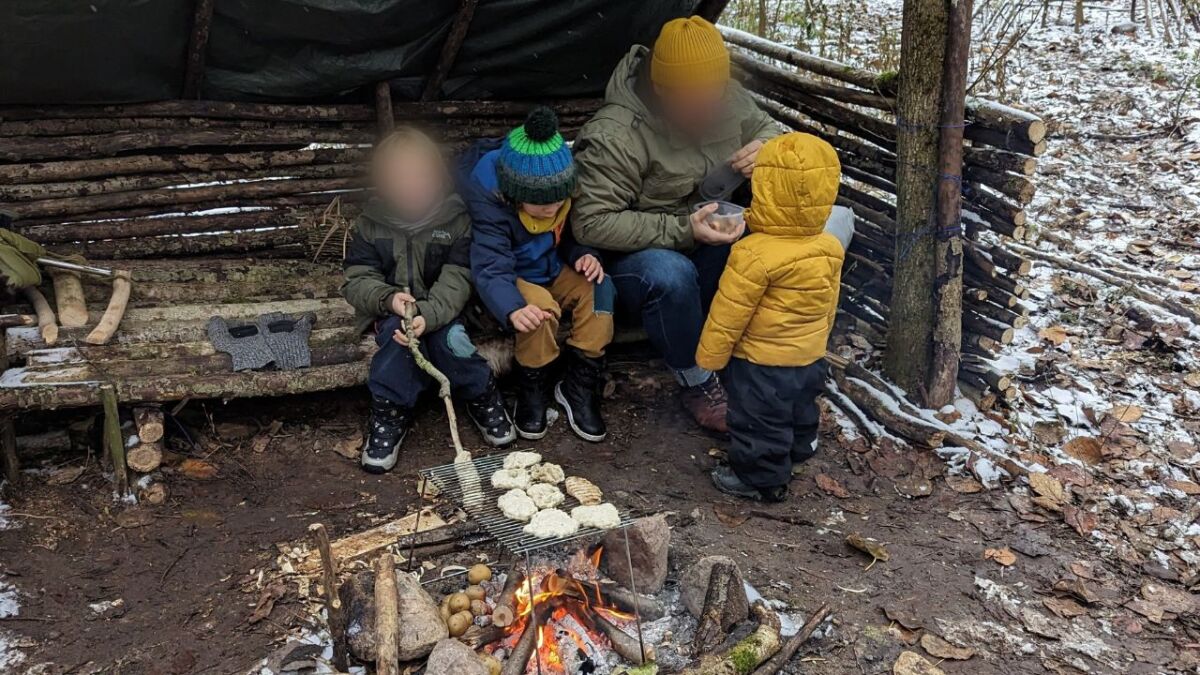
The taste is exactly the same and the good thing is that no one will be bored by the fire.
I basically only make my stick bread this way now because it's more relaxed for the whole family.
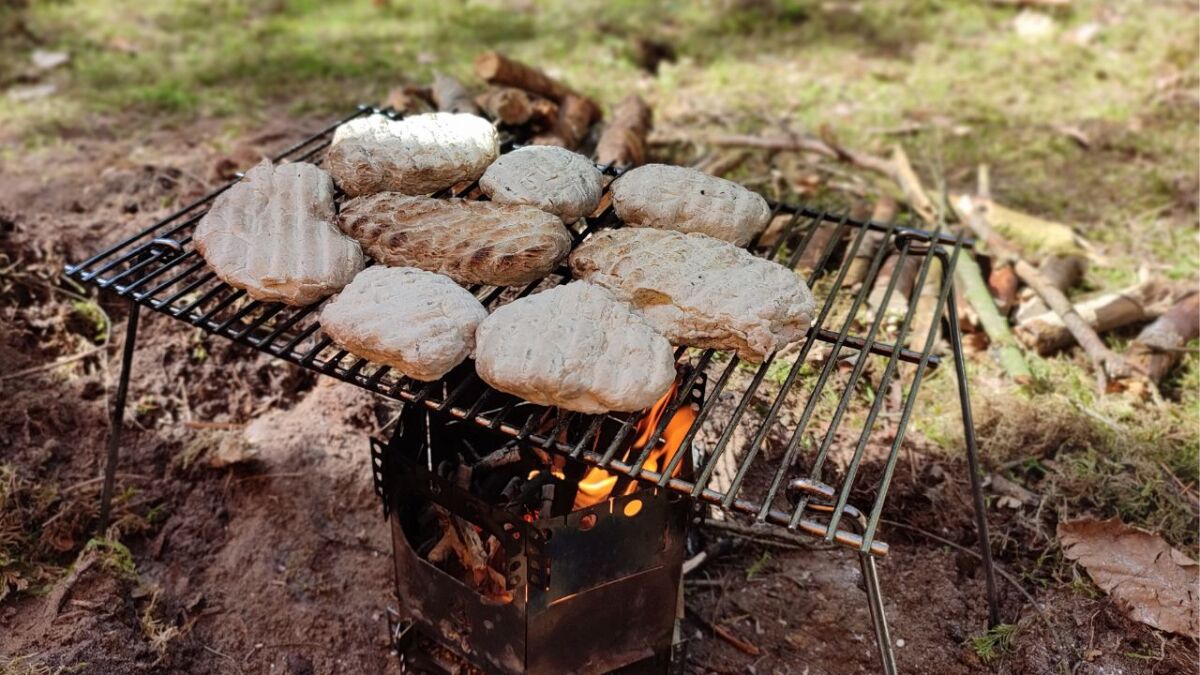
Simply place the grill grate over the embers and shape beautiful thin flat breads out of the dough. They should be thin because they will still rise and become at least as thick as a finger.
Then simply place them on the grate and let them bake slowly until crispy and brown.
A word of warning: Your children will be thrilled not to have to hold the stick anymore. It may happen that they never want to hold a stick again because of this method. 😛
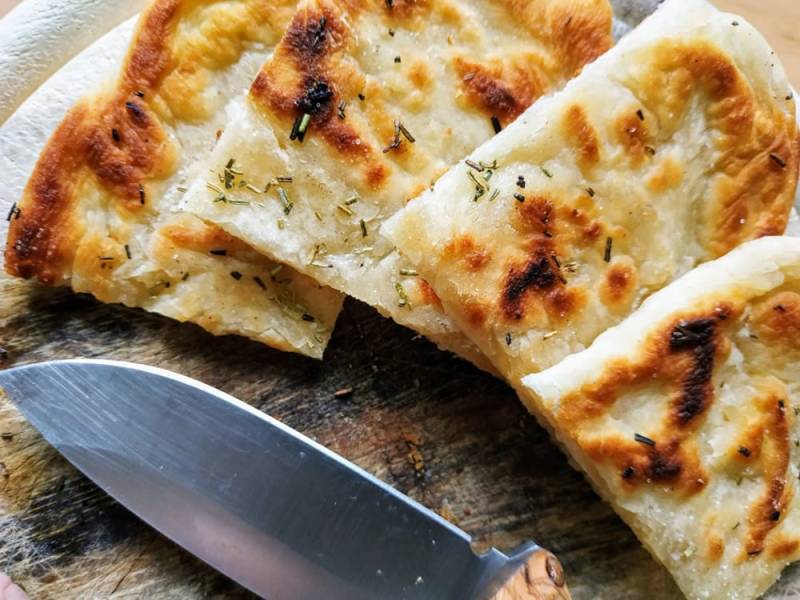
You can also always bake the dough in a pan. Just use some oil for baking.
Here's a little video from me:
Don't have a grill, no stick, and no pan?
Then simply place your flatbread in the embers. You'll be surprised how well that works. And don't worry: There won't be much ash on it.
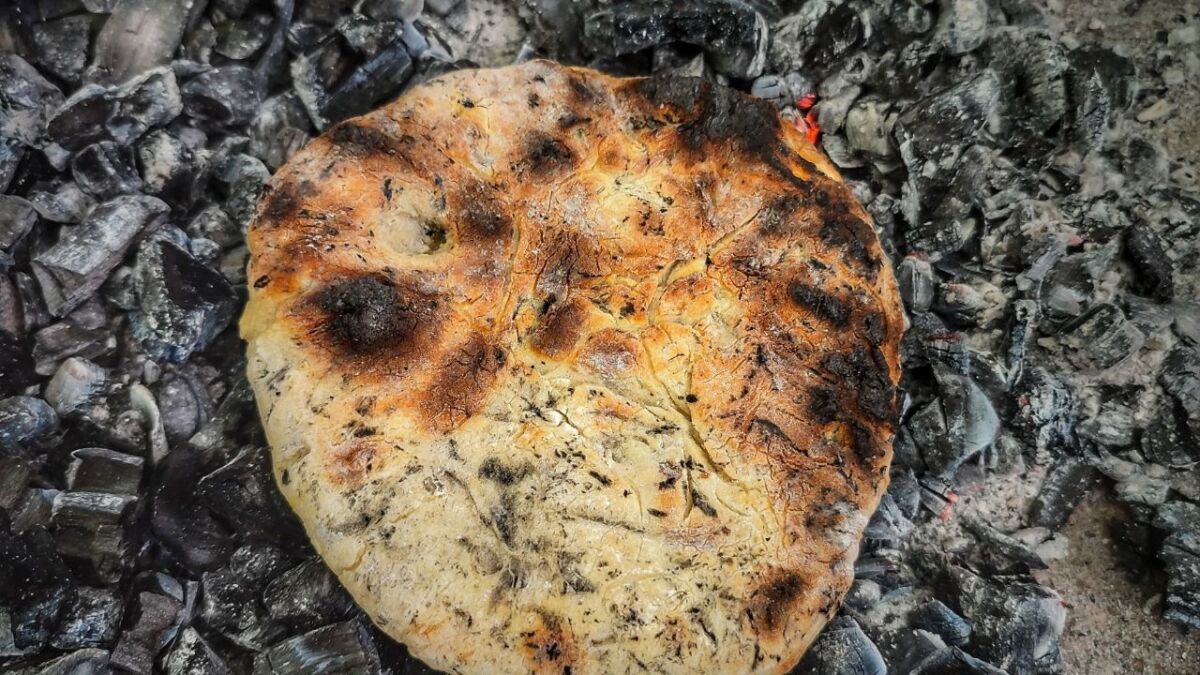
18 tips for baking stick bread
When baking stick bread, there are some tips you should consider.
Here are 18 tips for baking stick bread:
- Preparation is key: Make sure you have enough preparation time. Lighting the fire, preparing the dough, and baking the bread can take some time.
- Choose the right stick: Use a stick that is long enough to keep you at a safe distance from the fire and thick enough to hold the dough without breaking.
- Prepare the stick: Remove the bark from the stick and heat it over the fire before adding the dough. This helps to kill bacteria and makes it less likely for the dough to stick.
- Dough consistency: Make sure your dough is not too soft or too hard. It should be smooth and easy to wrap around the stick.
- Keep some flour: If you are outdoors, keep some flour on hand to correct dough that is too moist.
- Prepare the dough: Prepare the dough by rolling it into a long snake before wrapping it around the stick. This helps to ensure an even thickness and ensure that the bread cooks evenly.
- Not too much dough: Do not use too much dough at once. A thick dough can burn on the outside before it is cooked through on the inside.
- Keep distance: Do not hold the stick bread directly into the flames, but hold it over the embers. This helps to avoid burning and ensures even heat.
- Control the heat: Do not let the embers get too hot, as the bread can burn. A golden brown color is ideal.
- Turn regularly: You should turn the stick bread regularly to ensure even baking.
- Let it cool down: Let the stick bread cool down a bit before eating.
- Patience is key: Stick bread takes time to cook properly. Do not rush the process; otherwise you will end up with bread that is burned on the outside and raw on the inside.
- Maintain cleanliness: Make sure your hands and the stick are clean before starting. This will help keep unwanted flavors or bacteria away from your bread.
- Experiment: Feel free to experiment with different dough types and fillings. You can incorporate cheese, chocolate, or jam into the dough to create different flavors.
- Safety first: Always think about safety. Keep children away from the fire and make sure no one is waving the sticks around.
- Enjoy nature: Baking stick bread is a great opportunity to enjoy nature. Use the time to relax and enjoy the surroundings.
- Sharing is fun: Stick bread is a great food to share. Everyone can bake their bread, and it's fun to try different techniques and flavors.
- Leave no trace: After you are finished, don't forget to clean up the area and remove any traces of your fire (here's a video from me on the topic). It is important to leave nature as you found it.
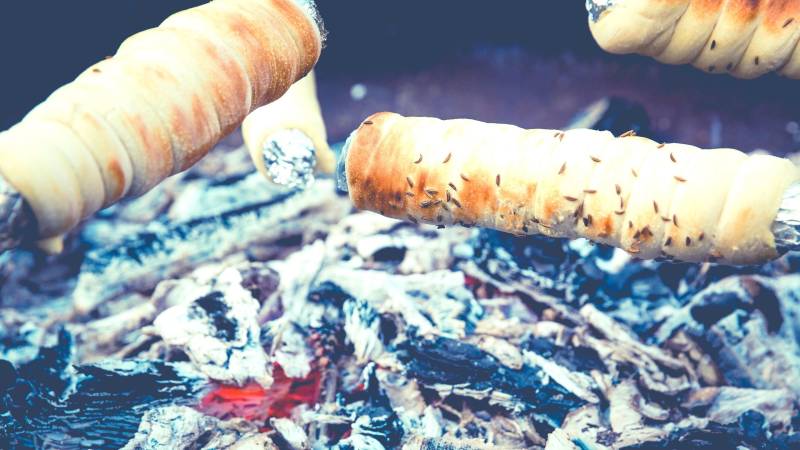
And now I wish you lots of fun baking and preparing.
You are welcome to leave a comment here, letting me know how you liked the recipes or what variations you tried.


Author of the guide
Martin Gebhardt
Hey, I'm Martin. On my blog, you will learn the basics and numerous details about living in the wild. I think survival, bushcraft and the good life in nature are the keys to happiness. Find me here on Instagram or on YouTube. You can find more about my mission on the About Me page.
Was this guide helpful?
19 people found this guide helpful.
5.00 out of 5 points (19 Ratings)
Comments (0)
This post may contain affiliate links. So if you click on the links and make a purchase, I will receive a small commission at no additional cost to you. Click here, to learn more about it.



